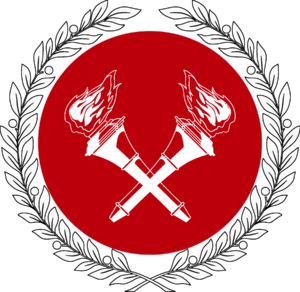Amathian Liberation Army
This article is incomplete because it is pending further input from participants, or it is a work-in-progress by one author. Please comment on this article's talk page to share your input, comments and questions. Note: To contribute to this article, you may need to seek help from the author(s) of this page. |
| Amathian Liberation Army | |
|---|---|
| Ⰰⱃⰿⰰⱅⰰ ⰴⰵ Ⰵⰾⰹⰱⰵⱃⰰⱃⰵ Ⰰⰿⰰⱚⱐ Armata de Eliberare Amathă | |
 Emblem of the Amathian Liberation Army | |
 Flag of the Amathian Liberation Army | |
| Motto | Ⱄⱆⱄ ⰿⱆⱀⱌⰹⱅⱁⱃⰹ ⱄⰹ ⰹⱀⰰⰹⱀⱅⰵⱔ, ⱂⰵ ⰴⱃⱆⰿⱆⰾ ⰿⰰⱃⰵⰹ ⰱⰹⱃⱆⱀⱅⰹ! Sus muncitori, și înainte, pe drumul marei biruinți! (Rise workers, and onwards, on the path of the great victory!) |
| Founded | 1 March 1934 |
| Disbanded | 4 January 1980 |
| Service branches | |
| Headquarters | East Arciluco |
| Personnel | |
| Conscription | Yes |
| Active personnel | 376,850 nominal, peacetime, 1979 961,350 nominal, wartime, 1979 |
| Industry | |
| Foreign suppliers | |
The Army for the Liberation of the People of Amathia (Amathian: Ⰰⱃⰿⰰⱅⰰ ⱂⰵⱀⱅⱃⱆ Ⰵⰾⰹⰱⰵⱃⰰⱃⰵⰰ Ⱂⱁⱂⱁⱃⱆⰾⱆⰹ Ⰰⰿⰰⱚⰹⰵⰹ, tr. Armata pentru Eliberarea Poporului Amathiei), usually known as the Amathian Liberation Army (Ⰰⱃⰿⰰⱅⰰ ⰴⰵ Ⰵⰾⰹⰱⰵⱃⰰⱃⰵ Ⰰⰿⰰⱚⱐ, Armata de Eliberare Amathă), abbreviated as AEA, represented the armed forces of the Amathian Council Republic and of the Amathian Equalist Republic. With its origins in the councilist partisans operating as a resistance force in Amathia during the Great War, the Liberation Army was officially reorganized into a fighting force during the Bloody Oath of the Field of Freedom in 1934. It played an extremely important role in the country's history and politics of Amathia throughout most of the century, helping establish the Council Republic, taking part in the liberation of eastern Amathia during the Solarian War, and becoming the primary supporter of the Equalists, which led to the Liberation Army being used to suppress dissidents and coups throughout the era of the Equalist Republic. The forces of the AEA then played the deciding role in the collapse of the regime during the Amathian Revolution, as military units refused the order to fire on the protesters and mutinied, joining the revolutionaries. With some of its higher ranking officers having fled abroad in order to avoid being tried for crimes against humanity, the Amathian Liberation Army was depoliticized and purged of criminal elements both during the Revolution and in the subsequent series of trials, before being reorganized into the Amathian Armed Forces.